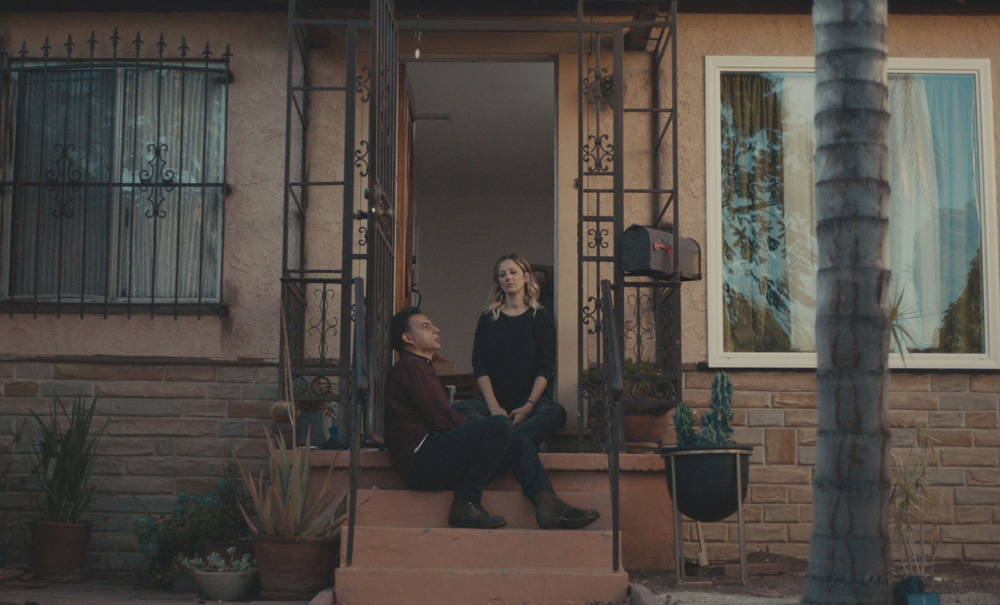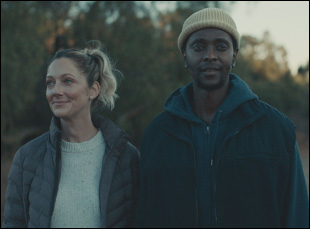If there’s a constant in Jared Moshe’s filmography to date, it’s that he’s liked to go back in time. His first two features “Dead Man’s Burden” and “The Ballad of Lefty Brown,” stood out amongst contemporary fare for heading back to the Old West for tales set immediately after the land grab era of settlement rife with greed and laws only as enforceable as individuals wanted them to be. In that sense, “Aporia” might not be seen as a departure when it involves the past and considers the morality around vengeance, yet it is the first of the writer/director’s films to take place in contemporary times where Sophie (Judy Greer) is left to raise her daughter Riley (Faith Herman) alone after her husband Mal (Eli Gathegi) died at the hands of a drunk driver. She isn’t completely on her own, visited on occasion by Mal’s friend and former co-worker Jabir (Payman Maadi), who had flirted with developing a time machine with Mal before his untimely passing, although it wouldn’t be one to take people back in time, but instead, ideally, weaponized to take bad actors out of history completely.
While there’s long been a question of assassinating an unquestionable villain such as Adolf Hitler to prevent the Holocaust, “Aporia” is more curious about the personal toll of making such a decision when Jabir and Sophie would both be justified in using the machine, which Jabir is adamant about after fleeing a country in which his family was killed by a dictatorship, but even if they can correct history to their liking, it doesn’t change the emotional cycle that began with their loved ones’ death and carries on even after they have them back in their lives. A jumble of used car parts and computers has far more power than it looks both in terms of efficacy and psychologically on Sophie and Jabir, for whom the countless wires emanating from the machine start to look like their own frayed nerves in considering the implications and filmed in the overlooked corners of Los Angeles, there’s a recognition that profound world changing events are happening in every home in the city, from the smallest apartments to its biggest mansions, on a daily basis, even if it’s just for the people living there.
After pulling off his previous westerns with immaculate detail on a shoestring budget, Moshe allows the emotional side of the story to transcend the physics of the stripped-down sci-fi and stirs suspense in watching Sophie and Jabir worry they’re turning into the evil they seek to erase and as the film was about to premiere at Montreal’s Fantasia Fest en route to a nationwide theatrical release in the U.S. this week, Moshe spoke about all the time he put into “Aporia,” working out both the emotional and quantum mechanics of the device at its center, and a story that was both literally and figuratively never too far from home.
There are two things — one was this idea I’d had for a gun that murders people in the past that I didn’t really know what to do with. I’d thought of it for a while and it just felt too big or too tropey, so I put it away for a little bit. Then my son was born right before we went into production on “The Battle of Lefty Brown” and that’s when I started suddenly feeling like the world became scarier and a lot more uncertain. Everything became a lot more important, trying to just protect my family and control the world so that I could keep my family safe. And as I was wrestling with this newfound sense of uncertainty, I started thinking, “Okay, this is something I want to explore through a film,” and trying to come up with the way to do that, I was like, “Oh, wait a minute, what about that gun idea? What if I use that as a way to show a character trying to protect the family to create a world that’s safe, what are the repercussions of that decision?”
I was surprised to hear you grew up reading Issac Asimov when I suspected you buried your head in Zane Grey westerns. Was dipping into sci-fi something you wanted to do for some time?
I’ve always loved sci-fi. I’d say I loved watching Western movies, but I loved reading sci-fi and I think I wrote a college essay about an Isaac Asimov quote, so getting into that world is something that’s always been really interesting to me. There’s a weird crossover between sci-fi and Western, which is they’re both ways to explore modern world using a genre that takes us outside of it. A Western allows us to look at the modern world through the past. Sci-fi gives you these crazy big ideas or to look at who we are today through invention or science that hasn’t been created yet. So the shift from Western to sci-fi was actually easier than I thought it would be because of that. And I know everyone loves “Foundation,” but I actually had always a soft spot for the Daneel Olivaw stories and [Isaac Asimov’s] murder mysteries like “The Naked Sun” or “Caves of Steel,” so I thought “Let’s do a sci-fi murder mystery,” and I love when sci-fi could be used to tell a really human, simple story, but in a grand way.

What happened was I wrote this right after “Lefty,” and then Bad Robot absolutely fell in love with it, and they had this idea of how to make it bigger and up the genre elements. We explored it with them for a couple of years, trying to make that a reality and we could never quite get it to work. So when the option was coming up, they did, the folks at Bad Robot did this really amazing thing and let me get my original script back, so I could make it at the level where it was written — this small intimate story that takes place in the neighborhoods you cut through on your way to work. So it was a great experience developing the film with them and super fun, but we just ended up going back to the original version of it.
It really does revolve around three central characters. Did they come to mind together or did they evolve in relation to one another?
I always knew it was going to be Sophie’s point of view [because] I wanted to tell a point of view of that person who was struggling with grief and loss and trying to regain her life. From that, her husband naturally became a character in the story and then Jabir [was a character] I’d always thought you see these movies [as the inventor of] a crazy cool machine, but it’s built by some rich, wealthy person who lives in Beverly Hills who’s got all the resources in the world. I wanted my machine to be from a person who’s got virtually nothing. He was this great physicist in his own country, but he’s an immigrant who’s now an Uber driver. He just drives a car and his intelligence is [considered] second tier, so how would that person build the machine like this? That was [where] I knew that I wanted the machine to come from, a place where you least expect it to.
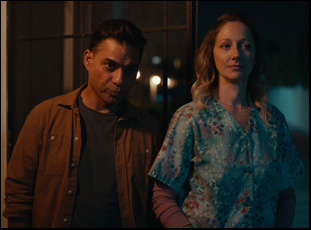
It was funny. The person who kept telling me she didn’t understand exactly how it worked — or “can you explain it again?” — was Judy. And I kept explaining to her, you’re the character who has to least understand how it works. You just need to understand what it does and the emotions repercussions of it. You shouldn’t know how it works. But I wanted it to feel really true to the characters. They needed to believe in it. So I like to sit down with my actors just talk through the script individually, so they can ask me any questions and we can figure out the process and find the character together a little bit.
While we were doing that, we would talk about how the machine worked and the science behind it, to the point where the actors were able to get into the belief that this could work. But also the idea of it is to look like a fire hazard — that was my instruction to my production designer. So I wanted them also to have the sense, especially when they first use it that maybe this is going to work, or maybe I’m going to start a fire and burn down the building. At one point, we had the idea of having all the power go out in the building, and then we realized we’re just in the middle of the day, so that effect doesn’t look very exciting — to have lights pop off in a building, it’s going to look exactly the same, but [we always wanted it to look like] it’s going to blow all the fuses and start a fire.
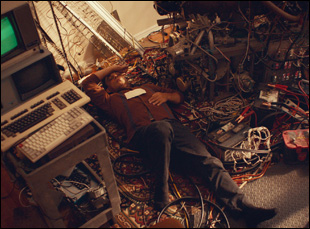
It was. We had two production designers, Ariel Vida, who was in charge of the machine, and then Katie Simon, who was in charge of the rest of the world. And Ariel has worked a lot with Moorehead/Benson and has done “Something in the Dirt” and has a shed that she’s been collecting junk from all her movies that she’s worked on, like ripped up parts of jukeboxes and all these like things, and suddenly she could use them [for “Aporia”]. So she just went into her shed and pulled all this stuff and I just [told her], “Just make it feel like shit was just welded together and they don’t know exactly what’s going to work and what won’t. They’re just trying something, and adding [onto] to it to the point where it’s like, “Well, this part could be doing something, but it might not, and we don’t really know, so we’ll just leave it.” She really just scrapped it together to feel like they did.
One thing that I felt carried over so well from your westerns was a sense of geography, which I wondered was different to think about in an urban setting?
One of the things I bring from having made two Westerns is understanding the land as a character and it was really important that L.A. became a character to me in this story — the geography, the space, and the real place. Most of it was shot in El Sereno in East L.A., and a part of L.A. that isn’t usually filmed. I remember someone came up to us once we were filming, like, “What are you doing?” And we’re like, “We’re filming a movie.” And they looked at us like, you’re filming a movie? In El Sereno? What are you doing?”
I really wanted it to have that texture and it was important to me to always think about how to get that into our world and our geography while we were shooting it. It also helped that we ended up shooting in the neighborhood where I live because I couldn’t find a house in L.A. that I liked that worked for this that we could afford on our budget. Then it turned out, my son was at a T-ball game and one of the families there was like, “Oh, we’re going away on a family trip.” And [asked] “What are those dates?” And it turned out it hit our dates [for the production], so we were able to give them some money to help them fix up their house and we got our location. But the weird thing of that was their house was around the corner [from] where we’re shooting our main location, so the trailers [for the cast] are in front of my house. And we were at the rec center down the street where where I go every day with my kids. The coffee shop is where I would go and work [regularly]. So it became an area that I knew really well and I was able to really infuse the sense of geography into it.
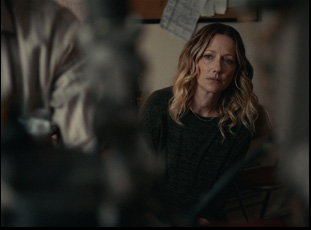
Yeah, it was interesting because when you’re shooting Western, you’re in the middle of nowhere and you’re dealing with weird weather, but you don’t have to deal with cars and people [you didn’t expect to be in the frame]. And it’s funny, I was like, “Oh, it’s going to be easier. I don’t have to direct horses. I don’t have to deal with a dust storm.” But suddenly it’s like, there’s the dude with the really loud car that’s driving by every now and again. But I really wanted to embrace that. This is supposed to feel a little bit like a documentary-ish and this could be happening in some neighborhood in L.A. that you don’t even realize, so [for instance] there’s the scene where Judy and Paymaan are on the street and they’re arguing, [and I thought] “Cool, let’s get the traffic going by. Let’s let the uncontrollable nature of it filter into our story” because this is a story that should feel a little dirty and uncontrolled, and we’ll figure out how to fix it later with the sound.
“Aporia” opens in limited release on August 11th. A full list of theaters and dates is here.




